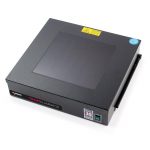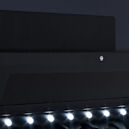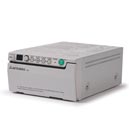- G:BOX F3
- Spacious darkroom
Image gels up to 32cm x 24cm - 5m pixel camera
Resolves close bands and detects nanogram amounts - Motor driven zoom lens and filter wheel
One click set up for easy image capture - Optional Lens Feedback available
Optimise image capture by using user protocols - White UV and blue lighting options
Flexibility to image fluorescent and visible stained gels - GeneSys application driven image capture software
Contains extensive database of dyes and imaging protocols. All you need to know is the type of gel you’re using and GeneSys automatically selects the optimal lighting and filters to produce the perfect image - GeneTools analysis software (unlimited copies)
Analyse data at your own computer

Versatile high resolution gel doc
An entry level system for imaging fluorescence and visible applications, the G:BOX F3 gel doc is the ideal solution for your laboratory.
Using your choice of dyes or stains, the G:BOX F3 automatically selects the right lighting and filters to detect close bands on both small and large gels. Choosing white light options for Coomassie Blue, UV and blue lighting options, ethidium bromide or SYBR® Safe gels, this system is the ultimate in gel doc flexibility.
The stylish and modular designed G:BOX F3 gel doc system includes a high resolution 5m pixel camera which is capable of giving outstanding images with incredible spatial resolution as well as a motor driven zoom lens and a motor driven filter wheel as standard. G:BOX F3 also comes with a Lens Feedback option allowing you to optimise your image capture using user protocols.
The system is controlled by GeneSys application driven image capture software and comes complete with unlimited copies of GeneTools analysis software.
Gel imaging for fluorescence and visible applications
Gel imaging for fluorescence and visible applications
| G:BOX F3 | |
|---|---|
| Image resolution (pixels m) | 5 |
| Effective resolution (pixels m) | 15.1 |
| A/D | 12/16 bit |
| Greyscales | 65536 |
| Quantum efficiency @ 425nm | 52% |
| Cooling | None |
| Lens (motor driven) | Zoom f1.2. Optional f1.2 with lens feedback |
| Filter wheel (7 position motor driven) | Yes |
| UV filter | Yes |
| Use with external PC | Yes |
| Darkroom | |
| Standard | Yes |
| Illumination | |
| Epi LED white lights | Yes |
| Epi UV 302nm | Optional |
| Visible light converter 33 x 31cm | Optional |
| White light pad for visible stains (20 x 14cm) | Optional |
| UltraBright LED blue light transilluminator 20 x 16cm | Optional |
| UV transilluminators | Optional |
| Dimensions | |
| Max image area (cm) | 32.5 x 24.1 |
| Min image area (cm) | 5.6 x 4.2 |
| W x H x D (cm) | 57 x 84 x 45 |
| Weight (kg) | 37 |
| Voltage | 115v/240v |
Accessories

Transilluminators
Syngene offers a range of UV transilluminators suitable for all your imaging needs. Transilluminators are available in 230V 50Hz, 230V 60Hz (-E60), 115V 60Hz (-A), 115V 60Hz (-ACA) and 100V 50/60Hz (-J). Available wavelengths are short wave (254nm, 2020S or 2530S), medium wave (302nm, 2020M or 2530M) and long wave (365nm, 2020L or 2530L).

UltraBright-LED transilluminator
Blue light transilluminators are often used as an alternative to a UV transilluminator when users wish to use ‘safe dyes’ instead of Ethidium Bromide. A blue light transilluminator is a ‘safe’ light source, in that the user is not exposed to harmful UV radiation and samples are free from photonicking. The UltraBright-LED transilluminator can be used instead of the UV transilluminator in all Syngene G:BOX systems.
UltraBright-LED transilluminator can be used with gels up to 20 x 16cm for use in the G:BOX series. This model uses side mounted 470nm LED arrays for illumination.

UV-blue light converter screens
These come in two sizes 21cm x 26cm and 25cm x 30cm and are used to change harmful UV into blue light. They are made of scratch resistant plastic and are easy to retrofit onto a UV transilluminator.

Visible light converter screens
These come in two sizes 30.5cm x 33cm and 23.5cm x 30cm and are used to change UV light into visible light, ideal for imaging Coomassie Blue and Silver Stained gels.

EPI UV
The EPI UV module can be fitted to any G:BOX darkroom (those produced after July 2010). The module fits above the standard LED white light module which is standard on all G:BOX systems. The EPI UV module can have either a 254nm, 365nm or 302nm tube. Either one or two modules can be fitted to each darkroom.

Filters
The filter wheel takes the 72mm range of filters.

Printer
Any printer with appropriate Windows drivers can be attached to the G:BOX F3. We recommend a thermal A6 printer such as Sony or Mitsubishi. These USB printers will ‘plug and play’ with the G:BOX F3 and require minimal setup. They will print hard copies of images in under 5 seconds on long life glossy thermal paper to give photographic quality images.
Thermal paper
Available as Matt or Glossy.
UV tubes
Short wave 8W, 254nm, Medium wave 8W, 302nm, Long wave 8W 365nm available.

IQ/OQ/PQ procedures
More and more laboratories require IQ/OQ/PQ verification these days. Syngene’s IQ/OQ/PQ procedures take the user through each step in the verification of a Syngene system in meeting the demands of the laboratory, regulatory compliances and standard operational procedures (SOP). These simple procedures allow the user to verify that a system meets defined installation, quality and performance specifications.
Installation Qualification (IQ)
This verifies that when a system is unpacked it conforms with all purchasing, shipping and unpacking documents. Once this procedure has been followed the system is then ready for the operational check process.
Operational Qualification (OQ)
This procedure establishes if the system meets all the operation and functionality specifications. An operational test is also included at this stage.
Performance Qualification (PQ)
A performance check will establish if the system meets the specification for the nature of the purpose it was intended for. This is verified by using a simple target to establish if the system can meet performance criteria.
Documentation
Each set of IQ/OQ/PQ documents contains a complete set of procedures and checklists for following the verification steps. Included with each ‘pack’ is a simple calibration device (target image) so that the performance of the system can be checked against the PQ requirements. Each set of documents is unique to a particular system and has to be ordered with the system itself. The document pack has full instructions for use and implementation.
Who does this?
Customer – typically a customer can perform these tests by themselves. Their own internal QC department will be familiar with these processes.
Syngene or its distributors
Trained Syngene personnel or trained distributors can also perform the IQ/OQ/PQ procedures, normally at a nominal charge.

